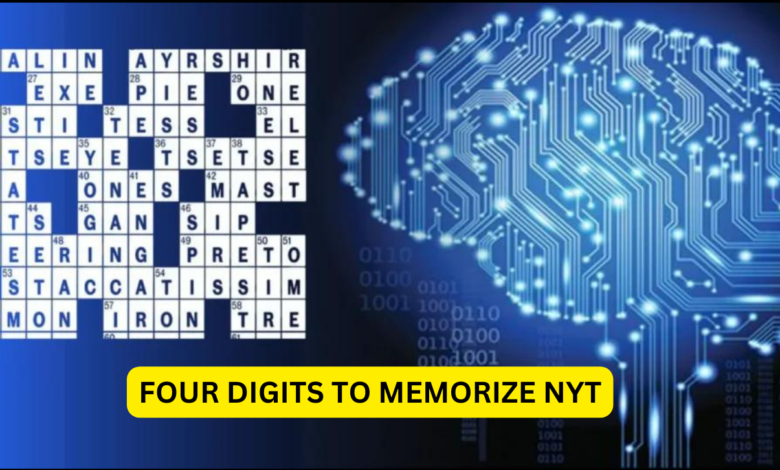Four Digits to Memorize NYT: Techniques for Unlocking the Power of Memory

In an age where information overload is a daily challenge, the ability to memorize and retain information efficiently is a skill that can set you apart. Whether you’re a language learner, memory enthusiast, or education tech user, mastering memory techniques can significantly enhance your cognitive capabilities. One such technique for making waves is the “Four Digits to Memorize NYT” method. In this blog post, we’ll dive into what this method entails and how it can be applied across various fields. We will also provide practical tips on how to use this technique effectively.
Introduction to the Concept of Memorizing Four Digits
The concept of memorizing sequences of four digits revolves around the idea that our brains are wired to recognize and recall patterns more effectively when broken down into manageable chunks. This technique isn’t merely about rote memorization; it’s about leveraging cognitive psychology to enhance memory retention. Focusing on four-digit sequences allows you to train your brain to store and access information more efficiently, particularly useful in today’s fast-paced, information-rich environment.
The “Four Digits to Memorize NYT” Method and Its Origins
The “Four Digits to Memorize NYT” method has gained popularity thanks to its mention in various cognitive science articles and educational resources. The method was initially inspired by the mnemonic techniques used by memory champions and cognitive scientists who study how the brain processes and retains information.
The essence of the method lies in breaking down larger pieces of information into four-digit sequences, making it easier for your brain to encode and retrieve these sequences. For instance, instead of trying to memorize a long number like 1234567890, you would break it down into 1234, 5678, and 90, making each chunk easier to recall.
Practical Applications in Language Learning, Memory Enhancement, and Education Technology
Language Learning
The “Four Digits to Memorize NYT” method can be a game-changer for language learners. Learners can improve their retention rates by breaking down vocabulary lists, grammar rules, or even phrases into smaller, four-digit-like sequences. For example, learning new words in groups of four related terms can make the learning process less overwhelming and more manageable.
Memory Enhancement Techniques
Memory enthusiasts will find that this method aligns perfectly with other memory enhancement techniques like the method of loci or the peg system. Incorporating four-digit sequences into these techniques allows you to create more robust and easily retrievable memory palaces or peg lists. This approach not only aids in memorization but also inefficiently retrieving stored information.
Education Technology
In education technology, the “Four Digits to Memorize NYT” method can be integrated into learning apps and digital platforms to help users retain information more effectively. Adaptive learning systems can use this method to present information in four-digit chunks, enhancing user experience and learning outcomes.
Testimonials and Case Studies
Case Study: John’s Language Learning Journey
John, a language enthusiast, struggled with retaining new vocabulary. He noticed a significant improvement after incorporating the “Four Digits to Memorize NYT” method into his study routine. By breaking down vocabulary lists into groups of four and associating them with visual cues, John could recall words more quickly and accurately during conversations.
Testimonial: Sarah’s Academic Success
Sarah, a student using education technology platforms, found that her retention rates improved dramatically when the platforms integrated the “Four Digits to Memorize NYT” method. The adaptive learning system presented information in digestible four-digit sequences, making it easier for Sarah to retain and recall the material during exams.
Tips and Resources for Using the “Four Digits to Memorize NYT” Method
- Start Small: Begin by applying the method to small tasks, like memorizing phone numbers or shortlists, to get comfortable breaking information into four-digit sequences.
- Use Visual Aids: Enhance your memory by associating each four-digit sequence with a visual cue or image. This can create a mental anchor that makes retrieval easier.
- Practice Regularly: Consistency is key. Integrate the method into your daily learning or memorization routine to see long-term benefits.
- Leverage Technology: Utilize education technology platforms that incorporate this method. These tools can offer structured and adaptive learning experiences that align with the “Four Digits to Memorize NYT” technique.
- Join Memory Communities: Participate in online communities and forums on memory techniques. Exchanging personal experiences and advice with individuals who share similar interests or goals can yield supplementary perspectives and inspiration.
Conclusion: The Benefits of Memory Techniques
The “Four Digits to Memorize NYT” method is more than just a mnemonic trick—it’s a powerful cognitive tool that can transform how you learn and retain information. Whether navigating a new language’s complexities, enhancing your memory skills, or leveraging education technology for better learning outcomes, this method offers a structured and effective approach.
One may achieve enhanced cognitive efficiency and facilitate ongoing personal and professional development by integrating this methodology into one’s daily regimen. Continually maintain a consistent approach and observe as your capacity to retain and retrieve information grows exponentially.
FAQ
What is the “Four Digits to Memorize NYT” method?
The “Four Digits to Memorize NYT”A method is a method in which lengthy fragments of information are decomposed into four-digit sequences. This facilitates the brain’s encoding and retrieval of information.
How does this method improve memory retention?
The brain can more effectively process and store this information by chunking information into more manageable four-digit sequences. This reduces cognitive load and makes retrieval of the information more efficient.
Can this method be used to learn languages?
Yes, the method is highly beneficial for language learners. Breaking down vocabulary, grammar rules, or phrases into four-digit-like sequences can make the learning process more manageable and improve retention rates.
Is the “Four Digits to Memorize NYT” method compatible with other memory techniques?
Absolutely. This method can be integrated with other memory enhancement techniques like loci or the peg system to create more robust and easily retrievable memory structures.
How can I start using this method in my daily life?
Begin with small tasks like memorizing phone numbers or short lists by breaking them into four-digit sequences. Use visual aids to enhance memory and incorporate regular practice to see long-term benefits.
Are any tools or apps supporting the “Four Digits to Memorize NYT” method?
Several educational technology platforms and learning apps are designed to incorporate this method, presenting information in four-digit chunks to improve user retention and learning outcomes.
What kind of results can I expect from using this method?
Many users, including students and language learners, have reported significant improvements in their recall and retention of information. Consistent use of the method can enhance cognitive efficiency and improve overall memory performance.
How do I integrate this method into my study routine?
Start by applying the method to small pieces of information and gradually expand to larger tasks. Consistency is key, so practice regularly and utilize technology to support your learning process.
Where can I find more resources and support for this method?
Interact in online communities and forums devoted to memory techniques. Many resources, including articles, videos, and discussion groups, can provide additional insights and support for incorporating the “Four Digits to Memorize NYT” method into your routine.



